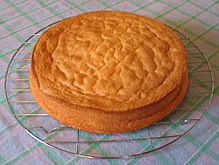Sponge cake
The sponge cake mixture is a loose mixture of beaten egg , sugar and a little flour that is used for fine pastries and cakes . A flat sponge cake base, which is baked from sponge cake on a baking sheet with a rim, is called a (biscuit) capsule . These are used to make desserts (slices or Swiss rolls ).
preparation
There are different methods of preparation. Sugars is beaten until fluffy with egg yolk, flour or a mixture of flour and cornflour mixed with the crowd, and finally to egg whites folded in beaten egg whites gently, after a few recipes also melted butter .
In modifications, bakers and confectioners also use ready-made flour to which only egg has to be added. This process is often used in crafts when the time required for traditional preparation is not worthwhile for small quantities.
Standard procedure
The sponge cake mixture contains little water and only a little starch, which makes the mixture very fluffy and frothy. For preparation, the egg yolk and the granulated sugar are stirred until they are frothy, which binds air in the form of small bubbles in the mass. The egg yolk gets between the sugar crystals, whereby the sugar crystals do not dissolve significantly due to the high fat content of the egg yolk, although the egg yolk contains water. In addition, the sugar crystals are separated from each other by the air bubbles.
"Two-kettle process": In the first kettle, egg yolks are mixed with 1/3 of the sugar and the flavors until frothy. In the second kettle, egg whites are whipped into egg whites with 2/3 of the sugar and salt. Then carefully mix the egg whites into the frothy egg yolk and fold in the sifted flour.
The flour is used to connect the mass with the help of the starch it contains. The water contained in the mass penetrates between the starch grains and connects them via capillarity . Since the water needs some time to penetrate via the capillary action, the dough should rest for a short time after mixing. The starch swells during baking and gelatinizes as the water evaporates. The dough is baked at high heat (around 200–230 ° C) on a baking sheet or in a baking pan, depending on how it is used. It is advisable to grease the baking pan beforehand or to cover it with baking paper to prevent the mixture from sticking.
After 15–20 minutes (longer depending on the baking pan) the dough can be pierced with an iron or wooden stick. If the dough does not stick to the sample, the mixture is sufficiently baked. If the sponge cake base is still warm, it can be rolled with the help of baking paper or a kitchen towel.
Alternative manufacturing processes
Génoise
The Génoise (named after the Italian Genoa ; also known as Genoese mass ) is a modification of the preparation of the biscuit mass, in which the egg white and egg yolk are stirred together until foamy ( single-boiler process or all-in process ), but this is more difficult can be done and takes longer. To support the process of frothing with air, it is advisable to first beat the eggs with the sugar in a water bath or over a gas flame at just under 40 ° C. The mass is then whipped without supply of heat until the mass has cooled down (> 15 min; cold-warm process ). Then the flour and the other ingredients are folded in.
If not enough air is blown in, baking powder can also be added. The baking powder creates carbon dioxide during baking , which, together with the air, loosens the dough.
The Génoise is z. B. used to make aniseed cookies, cakes and desserts.
Grillage
The grillage mass (Austrian) is a biscuit mass with pieces of brittle , breadcrumbs and almonds , which is typically seasoned with cinnamon . It is used in the pastry shop to make various pieces of dessert. As a cake base, it forms the crucial element of the grillage cake, which is filled with buttercream. Variants of this are characterized by the use of crispy ingredients such as brittle, almonds or nuts in the dough and the filling.
See also
Individual evidence
- ^ Josef Loderbauer: The baker's book in learning fields . Verlag Handwerk und Technik, Hamburg 2008, ISBN 978-3-582-40205-9 .
- ↑ Ternes, Täufel, Tunger, Zobel: Food Lexicon . Behr's Verlag, Hamburg 2005, ISBN 3-89947-165-2 , p. 737 .
